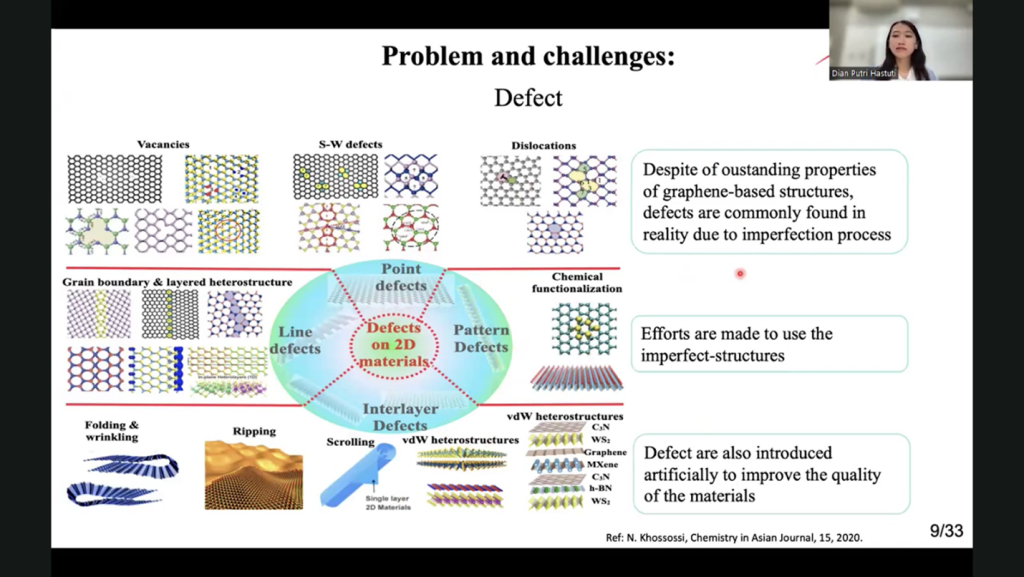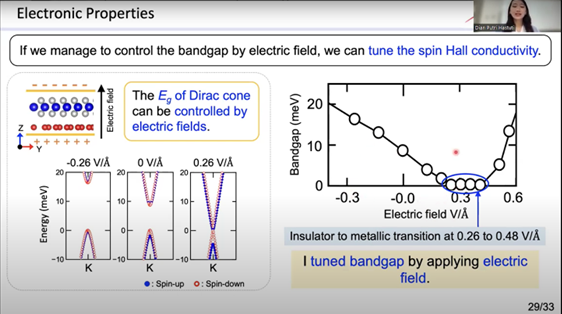Rebon Seminar is one of the routine activities of the Department of Physics, as a place to discuss and exchange ideas about research, studies, and phenomena according to the Field of Study Groups in Physics UGM. On May 22, 2024, the Rebon Seminar carried a theme around theoretical and computational physics with the topic “First – principles study of electric field effects on graphene-based heterostructures for battery and spintronics applications” presented by Dian Putri Hastuti, Ph.D, as a Researcher at the Research Center for Emerging Computing Technologies (RCECT) National Institute of Advanced Industrial Science and Technology (AIST), Tsukuba, Japan. This seminar activity was held online via the Zoom Meeting platform and moderated directly by the Coordinator of the Theoretical and Computational Physics KBK Dr. Dwi Satya Palupi, S.Si., M.Si.
The seminar began by introducing graphene material which has excellent properties so that it has potential as a material for devices. Excellent properties possessed by graphene include high thermal conductivity, large surface area, good mechanical properties, and very high electron mobility. Graphene is divided into several parts, namely single layer, multi-layer and hetero-structure. This sharing seminar focuses on multi-layer graphene applied to batteries and hetero-structure applied to spintronic devices.
In addition to having the advantages as previously described, researching graphene certainly has problems and challenges. The problems are defects and zero bandgap, while the challenge is tunability.



Details of graphene research problems and challenges
The purpose of the research described in this seminar is to determine the effect of external electric field on defected-graphene and its application to lithium battery anode, and to determine the effect of external electric field on bandgap graphene MoS2 hetero-structure and its application to spin generation. Meanwhile, the method used is the FLAPW method, which has the advantage of being able to calculate the external electric field effect on this 2D material accurately.
Electric field effects of Lithium Capacity in defected bilayer graphene
Electronic Properties: Control The bandgap by electric field, can tune the spin Hall Conductivity
From the research, it was concluded that the external electric field on defected- graphene can increase the capacity of lithium batteries. In addition, the effect of external electric field on band-gap graphene can control and enhance spin hall conductivity.
Sharing about the application of 2D graphene materials through this Rebon Seminar is an effort to support the achievement of the 4th pillar, 9th pillar, and 17th pillar. The Sustainable Development Goals are related to quality education, industry, innovation and infrastructure, as well as partnerships to achieve goals. The organization of this seminar provides an opportunity for participants to gain new knowledge about the DFT FLAPW simulation method and its application to batteries, improving the quality of education and learning in the field of materials and energy science. This seminar introduces the latest simulation methods in the field of materials and energy, encouraging innovation in the development of more efficient and environmentally friendly batteries. In addition, by introducing advanced simulation methods, this seminar can encourage the development of research infrastructure in academic institutions and industry. It can facilitate knowledge exchange and collaboration between researchers, academia and industry in the development of innovative battery technologies. By providing a platform for knowledge and experience sharing, this seminar can help strengthen the capacity of professionals in the use of DFT simulation methods for research and development. Thus, this seminar is not only a platform for knowledge and experience sharing, but can also make a significant contribution to the achievement of various Sustainable Development Goals (SDGs).
Author: Dina Wardiningsih
Photos: Dina Wardiningsih





